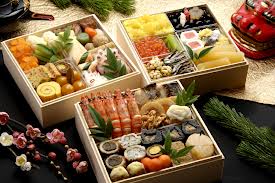 |
OSECHI RYORI
or
NEW YEAR FEAST
 |
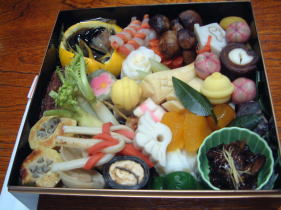 |
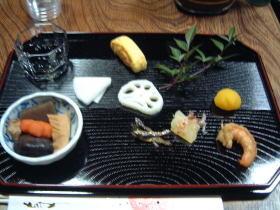 |
| Osechi is usually packaged in a multitiered box called juubako |
I'm sorry, this is a half-eaten osechi ryori |
Usually osechi ryori called just "osechi"
Osechi is a traditional special dish which is eaten during the first three
days of January.
The food is usually contained in two to five beautiful juubako lacquer ware boxes
which can be stacked( a nest of boxes). It means "to stack happiness".(In
recent years, we have osechi contained in one box)
There are many kinds of arrangements of dishes from one area to another,
but most of the parts are the same traditionally.
Because most of the osechi dishes have some special meanings to bring good luck,
and since they are plays on words or puns or imaginative meanings, they
should be included.
| Typical OSECHI | |||
| baika ninjin | 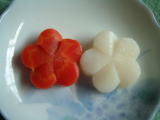 |
plum flower made of carrot | A plum flower surely bears a fruit |
| dashimaki-tamago | 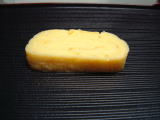 |
rolled omelette | Yellow color symbolize financial success, because in the Edo era the color of money of highest denomination was gold => yellow. And also the same meaning with "Datemaki". |
| datemaki | rolled omelette | *Datemaki look lile a scroll for calligraphic works and paintings, so people
wish success in education and progress of culture. *The word date came from a name of famous daimyo. He was smart and cool, and liked this food. So, date-maki symbolize these qualities. |
|
| ebi | 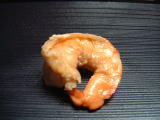 |
shrimp | Symbol of long life, because of its crooked back |
| gobou | 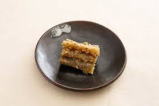 |
burdock | |
| gomame ⇒ tatsukuri |
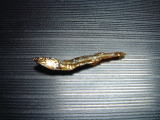 |
dried sweetened baby sardine |
see ⇒ tatsukuri |
Haze |
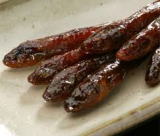 |
Gobioid/Goby | Goby's face looks like an Okina mask of Noh play. Okina is a symbol for long life. |
| kachiguri |  |
dried chestnut | Kachi means victory or to win. |
| kamaboko |  |
steamed fish- paste cake on a board |
Usually used in a red/pink and white combination. Redish color is symbol of avoiding evil/sun rising, and white is a symbol of purity. The color combination implies a happy cerebration. It also symbolizes daybreak because of its shape. |
| kazunoko | 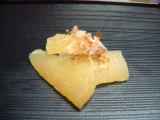 |
herring roe | 子宝 Herring in Japanese is "Nishin/鰊"and it's the same sound with Nishin/二親 which means parents. So, herring roe is a symbol of the prosperity of one's escendants and treasure all children.. |
| kobu-maki |  |
rolled kelp or seaweed | symbol of joy, because kobu is partly the homonym of yorokobu which means joy |
| kuri-kinton |
paste of sweet chestnuts and sweet potato |
Wishes good business and financial luck.. The color of chestnuts is the same as the money in Edo era. Kinton in kanji is "金団" |
|
| kuromame |  |
black soybean | Symbol of diligence and good health , becaise mame ( bean in Japanese) is the homonym of mame which means diligence and good health in Japanese. Work outside in good health and suntan like the clour of kuromame. |
| Kuwai | Arrowhead | Kuwai is a water plant. Harvest when they shoot out buds (between late November and late December) "Shoot out buds" in Japanese is "Me ga deru" and has the same sound as the ward for "show signs of success". |
|
| namasu | 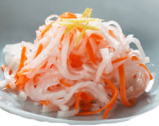 |
thin sliced vinegary radish and carrot |
The combination of the colour white in the radish and the color red in the carrot implies a happy cerebration. They look like "MIZUHIKI"usedin happy cerebration. |
| nishime | 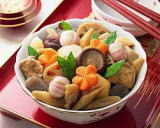 |
a kind of dry simmered dish of vegetables and chiken |
ex. gobo or burdock symbolizes energy because it root firmly underground.. renkon or lotus root implies hope of happiness in the future, because we can see something through the holes. Shiitake or Japanese mushrooms symbolize a career because it looks like a hat for samurai. |
| Satoimo | 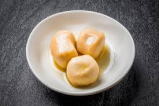 |
A parent rootstock (Oyaimo 親芋)has many young taro(Koimo/子芋) | |
| su-renkon | 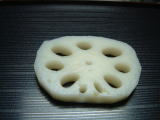 |
vinegared lotus root |
renkon or lotus root implies hope of happiness in the future, because we can see the future through holes. |
| takenoko |  |
bamboo shoot | symbol of force |
| tatsukuri or gomame |
 |
dried sweetened baby sardine |
Symbol of great crops of rice, because ta is the homonym of rice field and tsukuri means tsukuru which means make or raise in Japanese. A long time ago, dried young sardines were used as manure to enrich the rice field, so it was very important fish for rice and became a symbol of gettng good harvest and industriousness. |
| Tokobushi | 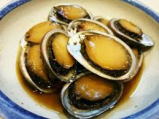 |
Another name is "Fukudame" which means "keep happiness" |
|